Posts Tagged: succulents
Exotics? Succulents?
I keep back issues of my favorite gardening magazines as do a lot of gardeners. We justify this magazine “hoarding” by telling ourselves that they are needed “in case I want to refer back”; but rarely do we look at anything in the stack again! Well, I’m here to suggest that we need to periodically check out those not outdated articles, and this blog serves as a good reason!
Years ago I subscribed to Flower & Garden, which was published back in the 1990’s – I know since my subscription ended with the January, 1996 issue. In the 1990’s, it seems that most people thought of succulents as exotic plants. These were meant to be carefully tended, shaded from the direct sun, kept from harsh temperatures, and planted in sandy, rocky soil.
Interesting, but since a lot of succulents come from either desert-like climates or cold, windy alpine mountains, it does seem that the coddling “required” was a bit much. Where are the succulents growing in your yard? In the full sun, away from winds (try that in Suisun or Fairfield!), in crumbly semi-moist soil? Mine are growing like weeds in pots outside in regular potting soil; they get water when “everyone else” does and they don’t get sheltered from the elements! Nope, mine thrive where they are, thanks!
The article continues on about picking out the right size pots: for a barrel type cactus, use a pot 1 to 2 inches wider than the plant; for vertical type plants such as aloes use a pot ½ the height of the plant.
I don’t have many specimen succulents here. I have creepers mixed with verticals and here and there they are interspersed plants that grow wider than tall. Everything spills, and tumbles out of the pots so that one succulent looks like it belong with the plants in the next pot over. One of my succulents is rangy, with leaves spaced a good 4 inches apart and a rather strange shade of pale green; not an attractive plant BUT when it blooms – wow! – pale yellow bell-shaped flowers abound in a semi-panicle form. It’s just beautiful! And then the flowers are through and it becomes its rather nondescript self.
Aloes, Agaves, Crassulas, Echeverias, and Sempervivums are plant groups that fall into the succulent category. Come to the plant exchange on October 12, and see the variety there. Thanks to Elizabeth who came to my house and harvested cuttings, there should be a goodly bunch for you to select from. Come and take the free plantlets and stay to listen to the various mini-talks by the Master Gardeners of Solano County.
Hope to see you there!
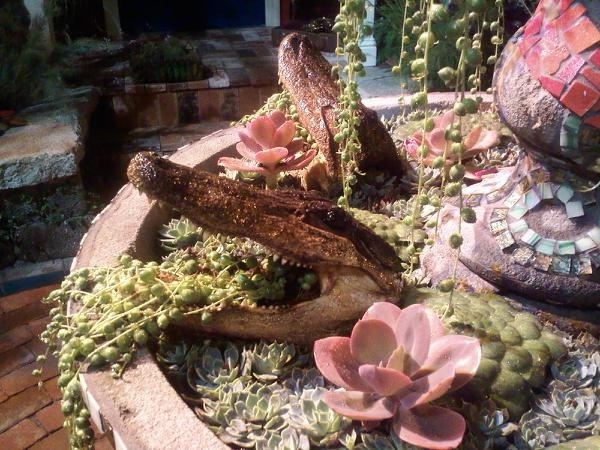
Crazy succulents! (photo by Jennifer Baumbach)
Succulent Boxes
In 2012, the Solano Master Gardeners held a class to make succulent boxes. We brought succulents from home and planted them in pre-made wooded boxes. The boxes had been constructed by volunteer Master Gardeners (or their husbands) who were gifted with building skills. The boxes were 6x6x3.5 inches, had a hardboard backing and ½ inch wire mesh on top. Everyone attending filled their boxes with soil, shared succulents and inserted them into the small spaces in the wire mesh. The group was loud and excited. It was a fun-filled, sharing, learning experience.
I came home so excited and mentioned to my husband that I wanted to make another succulent box BUT on a grander scale. Being the inventive and frugal person he is, he found a picture frame our neighbor had thrown in the trash, discovered some left over cement board in our garage and a yellowed piece of plastic lathe that was left over from building our patio. With those materials and a few screws, he created a succulent wall planter, 16x30x3 inches. He spray painted it ‘John Deere’ green so it would blend into the garden. It took awhile to fill each small opening in the lathe with the succulent cuttings I had been snipping from our garden. He placed two eye-hooks on each end of the box and hung it from the fence where two eye-bolts had been placed. This system makes rotating the box simple and keeps the soil inside from ‘slumping’. The first of each month, the box is taken down, placed across the top of our wheel barrow and watered thoroughly. We leave it flat for approximately an hour for the water to saturate the soil. Then it is hung in the opposite direction (using the eye-hooks on the opposite end).
This large succulent wall survived the winter with some minor frost damage. I did not cover it or provide protection last winter. This winter I plan to protect it with frost cloth or move the box into the garage. The frost damaged succulents were removed and NOT replaced. The plants not damaged have grown significantly and now cover the empty holes in the lathe.
The box has turned into a traveling planter, being a display item at the Dixon May Fair. When it returned home, it was not placed in the initial hanging spot. It presently hangs against the garden cottage wall next to the covered patio. It makes quite a statement as you walk down the brick pathway to enter the backyard garden.
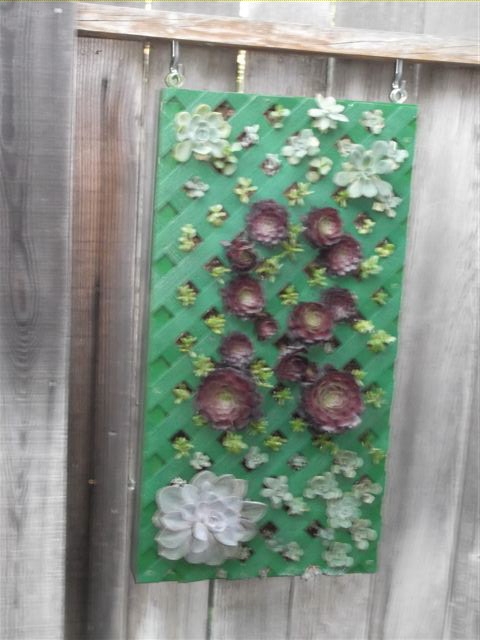
Sorry, picture a little blurry, but it's the start of the succulent box. (photos by Sharon Rico)
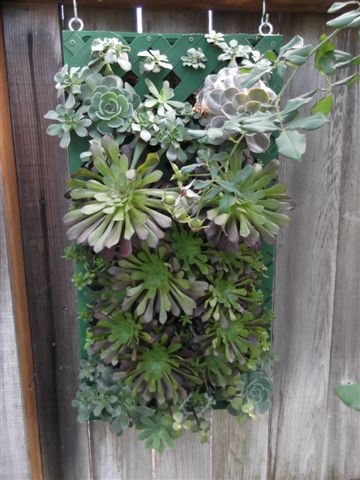
Succulents maturing in the box.
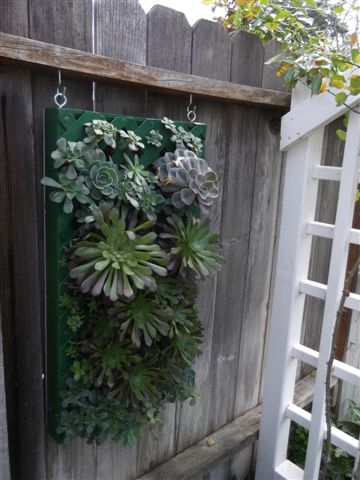
The final product is pretty nice.
Succulents Suck You In
Succulents, ahhh succulents … the subject of my final presentation for my Master Gardener certification. It seemed like such a simple straight-forward topic. But once my ‘presentation partner’ and I started delving into details, it became quite clear that it is a very HUGE and broad topic! So then our task became, “how do we narrow this down to focus on something informative and interesting?”
So after much research, including nearly every book about the broad subject of succulents (or at least it felt that way!), we decided to provide an overview of the 3 types and then show examples of each type – focusing on one in particular, the seemingly ‘most popular’ or certainly prevalent in this area, the stonecrop family.
I will begin by quoting from a document provided by the Ruth Bancroft Garden in Walnut Creek:
Succulents. Almost everyone is familiar with the term. Yet questions such as “is that Aloe a member of the succulent family?” reveal basic misconceptions on the part of many people as to just what a succulent is. The core of the problem here is that the term “succulent” is merely a descriptive term and not a scientific classification. Thus any plant that has evolved swollen water-storing tissues as a protection against desiccation is succulent by definition, regardless of what family it belongs to. A few families, such as the Crassulaceae (the stonecrop family, which includes plants such as the Hen-and-Chicks and jade trees) are composed entirely of succulents. But in many other cases, succulence occurs only in certain groups of a family of largely non-succulent plants.
The three types of succulents are leaf, stem and root, and as you might surmise from above (or perhaps already know), the plants store water in each of these areas, and in some cases two areas. An example of this is the jade tree, which is both a leaf succulent and a root succulent. And as you can see in the picture above, succulents come in all shapes and colors, which can add a lot of beauty to your garden or landscape.
I think one of the biggest lessons that we learned in researching this topic is that succulents are extremely forgiving and are therefore a great choice for any gardener … beginning gardeners will love the ease of planting them (break off a piece from your neighbor’s beautiful plant — with their permission of course! — and just put that right into the ground), and seasoned gardeners will appreciate their beauty and variety. Plus in these times of water-wise landscaping everyone will appreciate the fact they don’t require a lot of water very often. So, whether around your property or in pots, my research shows that succulents are nearly a perfect planting option!
Oh, but a word of caution, don’t be fooled by these beauties below as I almost was …. the invasive Ice Plant of the Aizoaceae Family. This plant offers a variety of beautiful flowers, tolerates blazing sun and spreads quickly, but the latter is exactly why you should avoid it! It will take over your entire yard, so buyers beware!
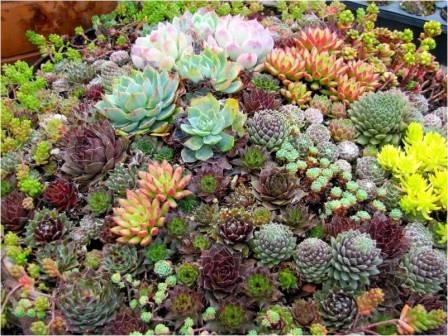
Variety of succulents. (photo from Recycle Reuse Renew Mother Earth Projects)
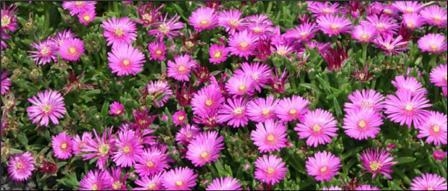
Invasive, indestructable ice plant. (photo by JoEllen Myslik)
A Succulent Lover's Paradise
While running errands in Walnut Creek several years earlier, I drove past a seemingly large public garden nestled in a residential neighborhood, the location of which seemed oddly out of place to me at the time (it turns out that the garden’s location made perfect sense, for the reasons discussed herein). I learned that the name of this garden was, “The Ruth Bancroft Garden,” which caught my eye. Having graduated from UC Berkeley, the name "Bancroft" meant something, as it is the name of one of the major research libraries on campus as well a street that borders the south side of the university--turns out that this association was correct.
I arrived early one Sunday morning to visit this garden. Seeing as I was the only one there, a knowledgeable and enthusiastic docent named Kimberly, was kind enough to take me on a wonderful tour of the garden. Kimberly explained that a 400-acre walnut and pear orchard founded by historian and publisher, Hubert Howe Bancroft, once stood where the Ruth Bancroft Garden is currently situated. In 1939, Hubert Howe Bancroft’s grandson, Philip Bancroft, and his wife, Ruth Bancroft, moved onto the property. Although Mrs. Bancroft had been a long-time, avid gardener, it was not until the 1950’s, that she began collecting succulents.
The family farm continued to operate until the 1960’s, at which time, the property was re-zoned for residential use and sold to developers who were developing the town of Walnut Creek. The last walnut orchard on the farm was razed in 1971, at which time, Mr. Bancroft reserved and gave Mrs. Bancroft, 3.5 acres with which to plant her collection of succulents, numbering in the thousands by that point. It is on that very plot that the Ruth Bancroft Garden is now located.
Mrs. Bancroft was in her 60’s when she started planting her succulent garden. Having had architectural training, Mrs. Bancroft designed the planting layout and grouped plants according to her artistic sensibilities rather than on the geographical origin of the plants as one would find in a botanical garden, while Lester Hawkins of Western Hills Nursery, designed the overall layout of the garden beds and paths. Indeed, a visitor to the garden will find a carob tree, a white gum eucalyptus tree, pine trees, etc., planted next to, or near,large agave plants and aloes, because Mrs. Bancroft found the contrast in color, texture, and structure of these diverse plants, pleasing. Mrs. Bancroft continued to work in and on her garden into her 90’s, and the garden continues to be maintained in her spirit to this day (e.g., palm fronds are not trimmed, as that was Mrs. Bancroft’s preference, and small, delicate metal tags reminiscent of a home garden, serve to identify the plants, rather than the heftier, wooden markers commonly found in botanical gardens). In 1989, the Ruth Bancroft Garden became the first preservation project of The Garden Conservancy, a non-profit organization whose mission is to conserve exemplary examples of American gardens.
Kimberly said that visitors from near and far come to visit the Ruth Bancroft Garden, because it contains unusual and hard-to-find succulent specimens. Although the garden changes throughout the year, Kimberly recommended visiting in May when many of the plants are in bloom.
For more information, please see http://www.ruthbancroftgarden.org/.
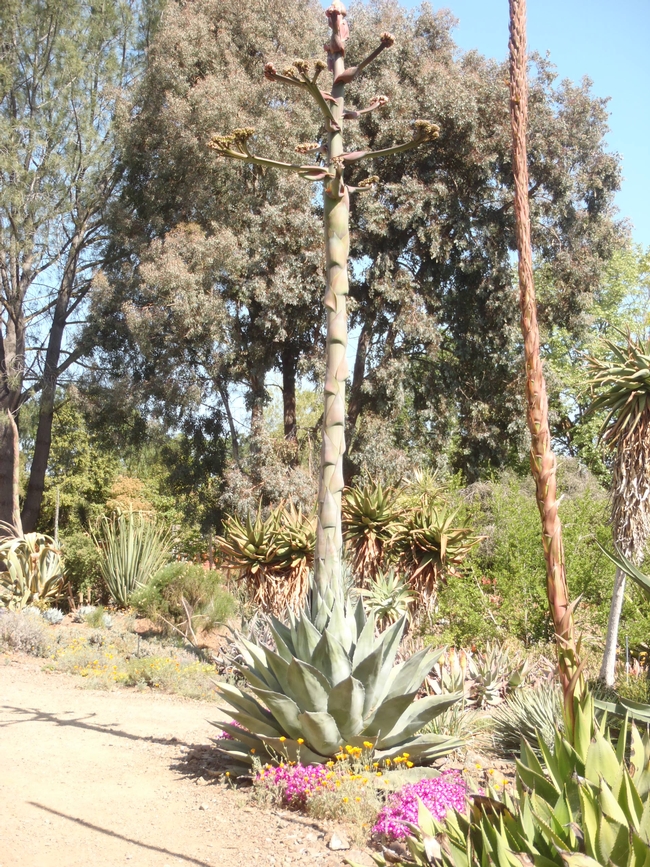
agave ruth bancroft
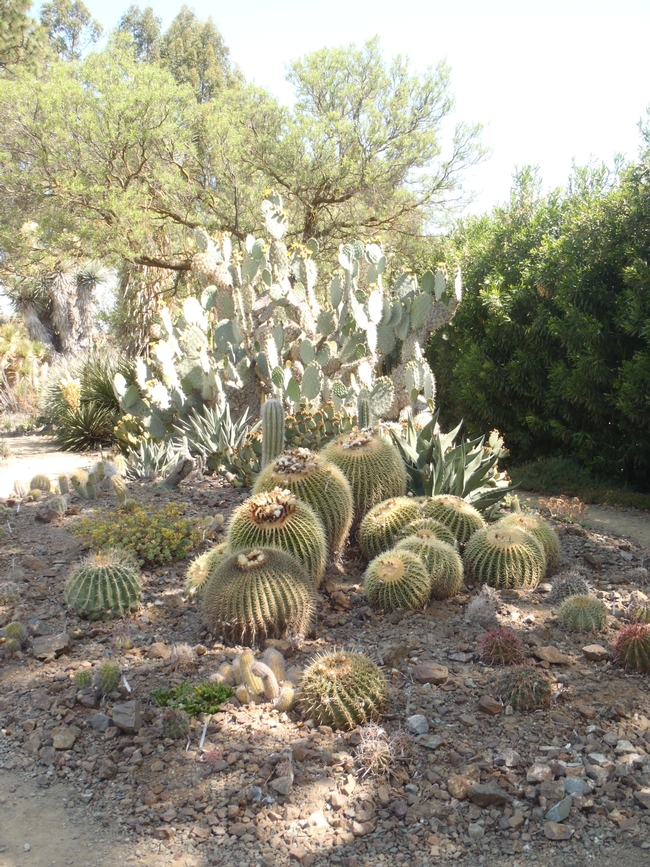
barrell cactus
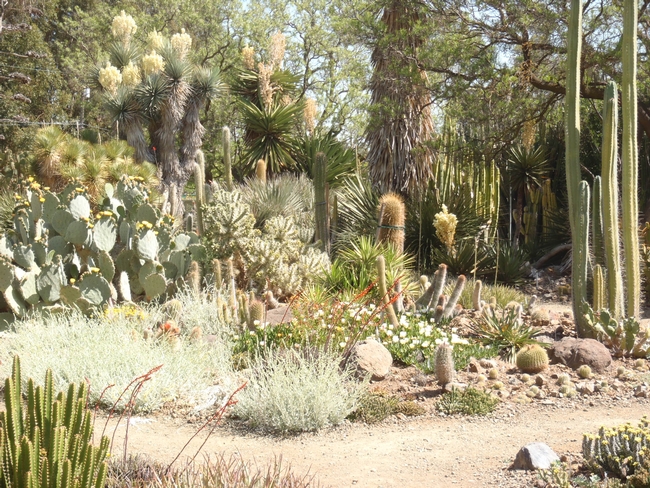
cactus ruth bancroft
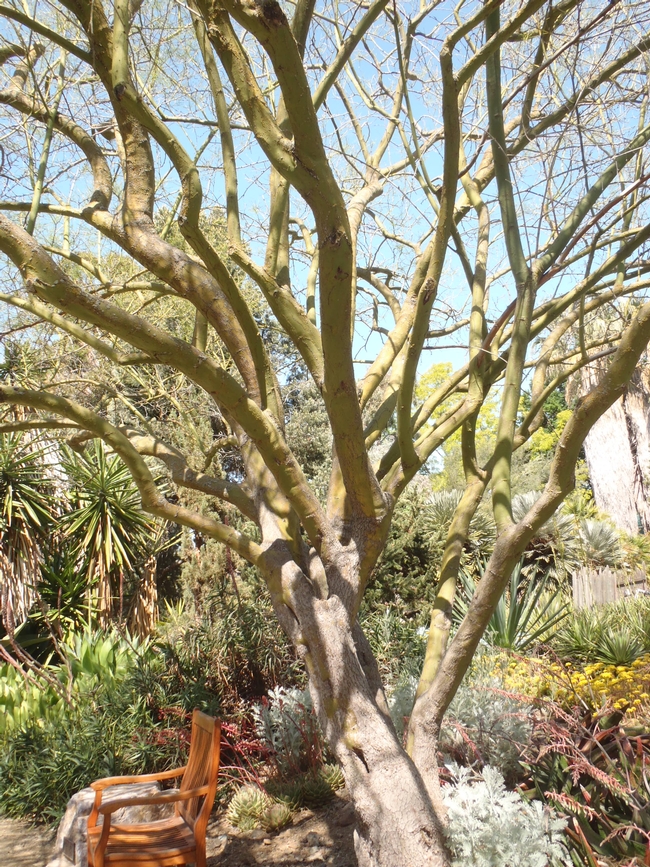
ruth bancroft tree
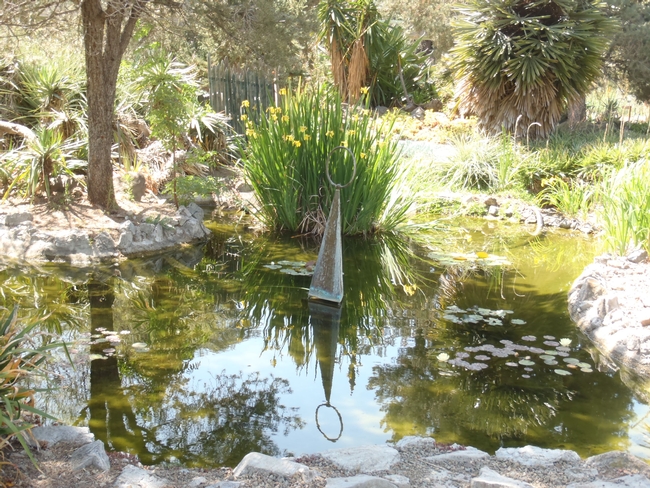
water feature ruth b
Succulents are Super!
Last month, the San Francisco Flower and Garden Show delivered its usual spring dose of inspiration. One of the most jaw-dropping exhibits was a huge rotating globe totally covered in succulents. The succulents were grouped in such a way that the different colors represented the continents and oceans. It was magnificent.
I also had the opportunity to attend a lecture on succulent maintenance by Robin Stockwell from Succulent Gardens in Castroville. It turns out, they were the team behind the globe. The finished globe weighs over a ton. The team started planting in late August-early September for the late March show. The globe has about 30,000 cuttings. Someone from his team has sent in paperwork to the Guinness Records organization to see if it might be the largest succulent planting in history.
Aside from the interesting background of the construction of the globe exhibit, Mr. Stockwell gave us many succulent pointers. He suggested a mixture of one part perlite to four parts regular potting mix for a custom succulent potting mixture. He fertilizes with half strength of a balanced fertilizer (he stated it didn't really matter what kind) once a month.
His pruning demonstration led to audible gasps from the crowd as he cut off a lovely Aeonium rosette. He explained that the larger the stem, the longer it would take for the cut to scab over and be ready for planting. He estimated that the piece he had cut would take two weeks before it would be ready to plant. He also suggested cutting the resultant tall stem left on the remaining plant down further so that branching would occur lower down. This cut he advised making at an angle so that water would not accumulate in the cut and lead to rot.
For those of you who didn't make it to the show, Mr. Stockwell mentioned that they are looking into taking the globe on tour. (The logistics of that make my brain spin) Hopefully, in the meantime, the photos will help. I must say though that photos don't do it justice.
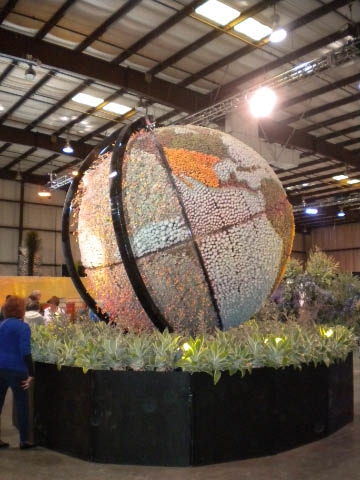
Succulent globe. Photos by Karen Metz
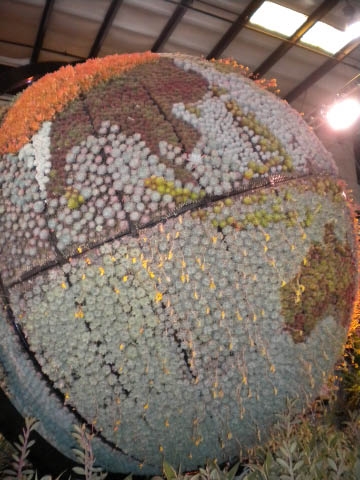
succulent globe 2

